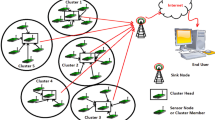Abstract
A wireless sensor network is a network of nodes spread across the application field with sensors attached to them, helping them sense the environmental parameters and transmit the data to the base station for further computation. Because of low battery power of sensor nodes, energy efficient routing in the sensor nodes is very important for a good network lifetime and throughput. Clustering of nodes by formation of groups is an effective routing technique which involves transmission of data from the nodes to the head of the cluster and then the transmission of the accumulated data from that cluster head to the base station. In this paper, a new clustering based routing protocol is proposed which shows significant improvement in the network lifetime, stability of network, throughput of the network and the average energy of the network as compared to the conventional clustering based routing algorithms. The nodes in the network field have been deployed according to the gauss function instead of a random distribution. Also, the base station has been made mobile and it’s movement is according to the sigmoid function. Initial energy and current energy of nodes along with average energy of network have been taken into consideration in several computations to modify the conventional clustering routing algorithm. This proposed protocol i.e. Gauss-sigmoid based clustering routing (GSCR) protocol is compared with SEP, LEACH and DEEC protocols for performance evaluation and for exhibiting its improvement in the performance parameters. Significant improvement is exhibited in terms of network lifetime, throughput, stability period and the average energy of the network.






Similar content being viewed by others
References
Kukreja D, Dhurandher SK, Reddy BVR (2018) Power aware malicious nodes detection for securing MANETs against packet forwarding misbehavior attack. J Ambient Intell Humaniz Comput 9(4):941–956. https://doi.org/10.1007/s12652-017-0496-2
Potdar V, Sharif A, Chang E (2009) Wireless sensor networks: a survey. In: 2009 International conference on advanced information networking and applications workshops. https://doi.org/10.1109/waina.2009.192
Coca E, Popa V, Buta G (2009) Wireless sensor network nodes performance measurements and RSSI evaluation. In: 2009 15th international symposium for design and technology of electronics packages (SIITME)
Healy M, Newe T, Lewis E (2008) Wireless SenorNode hardware: a review. In: IEEE sensors 2008 conference
Gui T et al (2016) A novel cluster-based routing protocol wireless sensor networks using spider monkey optimization. In: IECON 2016—42nd annual conference of the IEEE industrial electronics society. pp 5657–5662
Singh SK, Kumar P, Singh JP (2017) A survey on successors of LEACH protocol. IEEE Access 5:4298–4328
Palan NG, Barbadekar BV, Patil S (2017) Low energy adaptive clustering hierarchy (LEACH) protocol: a retrospective analysis. In: 2017 International conference on inventive systems and control (ICISC)
Heinzelman WB, Chandrakasan AP, Balakrishan H (2002) An applocation-specific protocol architecture for wireless microsensor networks. IEEE Trans Wirel Commun 1(4):660–670
Pant Y, Bhadauria HS (2016) Performance study of routing protocols in wireless sensor network. In: 2016 8th international conference on computational intelligence and communication networks (CICN)
Smaragdakis G (2004) SEP: a stable election protocol for clustered heterogeneous wireless sensor networks. OpenBU
Qing L, Zhu Q, Wang M (2006) Design of a distributed energy-efficient clustering algorithm for heterogeneous wireless sensor networks. Comput Commun 29(12):2230–2237
Qureshi TN, Javaid N, Malik M, Qasim U, Khan ZA (2012) On performance evaluation of variants of DEEC in WSNs. In: 2012 Seventh international conference on broadband, wireless computing, communication and applications
Sharma DK, Bagga S, Rastogi R (2019) Energy efficient improved SEP for routing in wireless sensor networks. In: Bhatia S, Tiwari S, Mishra K, Trivedi M (eds) Advances in computer communication and computational sciences. Advances in intelligent systems and computing, vol 924. Springer, Singapore
Nayak P, Devulapalli A (2016) A fuzzy logic-based clustering algorithm for wsn to extend the network lifetime. Sens J IEEE 16(1):137–144
Hammoudeh M, Newman R (2015) Adaptive routing in wireless sensor networks: QoS optimisation for enhanced application performance. Inf Fusion 22:3–15
Zahedi ZM et al (2016) Swarm intelligence based fuzzy routing protocol for clustered wireless sensor networks. Expert Syst Appl 55:313–328
Nuruzzaman MT, Ferng HW (2016) A low energy consumption routing protocol for mobile sensor networks with a path-constrained mobile sink. In: 2016 IEEE international conference on communications (ICC). Kuala Lumpur, pp 1–6
Al-Baz A, El-Sayed A (2018) A new algorithm for cluster head selection in LEACH protocol for wireless sensor networks. Int J Commun Syst 31(1):e3407
Razaque A et al (2016) P-LEACH: energy efficient routing protocol for wireless sensor networks. In: 2016 IEEE long island systems, applications and technology conference (LISAT). IEEE
Guo W, Zhang W, Lu G (2010) PEGASIS protocol in wireless sensor network based on an improved ant colony algorithm. In: 2010 Second international workshop on education technology and computer science
Chaurasiya H, Ghosh S (2019) Energy efficient evolutionary SEP clustering protocol for wireless sensor network. Int J Online Sci 5(1):6
Taj MBM, Kbir MA (2016) ICH-LEACH: an enhanced LEACH protocol for wireless sensor network. In: 2016 International conference on advanced communication systems and information security (ACOSIS), Marrakesh. pp 1–5
Mukherjee P, Samant T, Mayee T, Swain T, Datta A (2017) A hybrid and energy saving approach for hierarchical routing protocol using SEP-VD. In: 2017 1st International conference on electronics, materials engineering and nano-technology (IEMENTech), Kolkata. pp 1–6
Author information
Authors and Affiliations
Corresponding author
Rights and permissions
About this article
Cite this article
Sharma, D.K., Kukreja, D., Bagga, S. et al. Gauss-sigmoid based clustering routing protocol for wireless sensor networks. Int. j. inf. tecnol. 13, 2569–2577 (2021). https://doi.org/10.1007/s41870-019-00391-x
Received:
Accepted:
Published:
Issue Date:
DOI: https://doi.org/10.1007/s41870-019-00391-x




